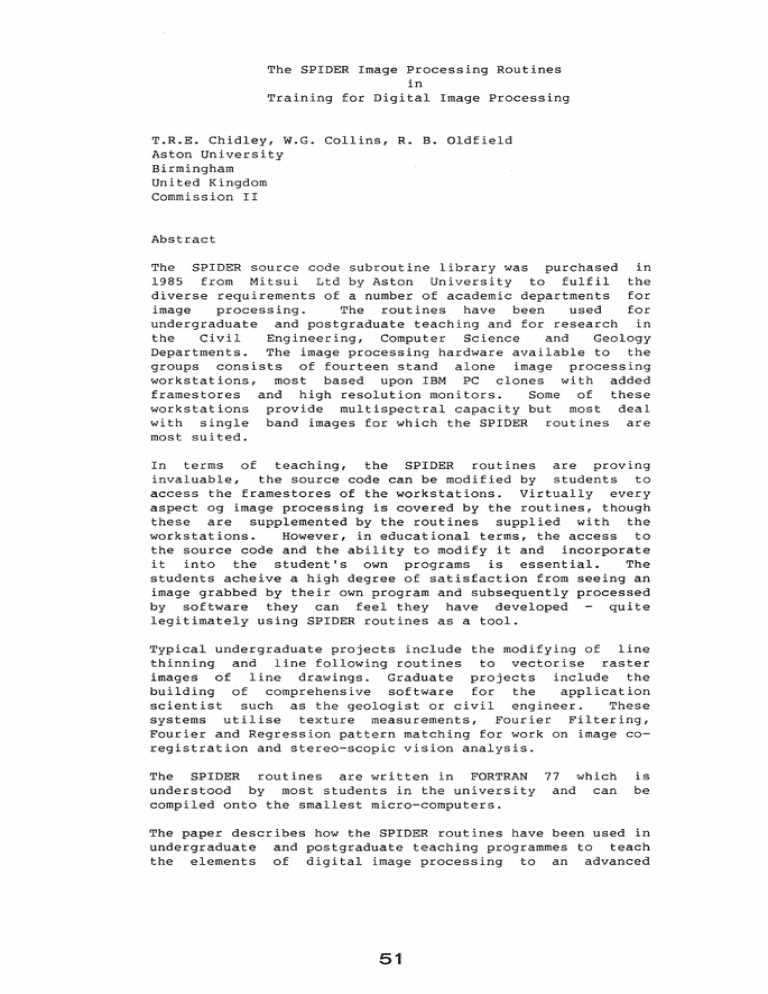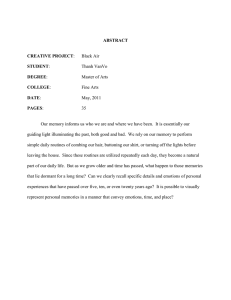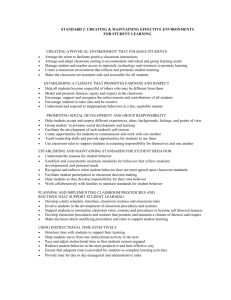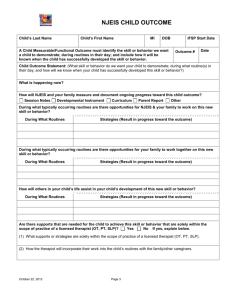The SPIDER Image Processing Routines in
advertisement

The SPIDER Image Processing Routines in Training for Digital Image Processing T.R.E. Chidley, W.G. Collins, R. B. Oldfield Aston University Birmingham United Kingdom Commission II Abstract The SPIDER source code subroutine library was purchased in 1985 from Mitsui Ltd by Aston University to fulfil the diverse requirements of a number of academic departments for image processing. The routines have been used for undergraduate and postgraduate teaching and for research in the Civil Engineering, Computer Science and Geology Departments. The image processing hardware available to the groups consists of fourteen stand alone image processing workstations, most based upon IBM PC clones with added framestores and high resolution monitors. Some of these workstations provide multispectral capacity but most deal with single band images for which the SPIDER routines are most suited. In terms of teaching, the SPIDER routines are proving invaluable, the source code can be modified by students to access the framestores of the workstations. Virtually every aspect og image processing is covered by the routines, though these are supplemented by the routines supplied with the workstations. However, in educational terms, the access to the source code and the ability to modify it and incorporate it into the student's own programs is essential. The students acheive a high degree of satisfaction from seeing an image grabbed by their own program and subsequently processed by software they can feel they have developed quite legitimately using SPIDER routines as a tool. Typical undergraduate projects include the modifying of line thinning and line following routines to vectorise raster images of line drawings. Graduate projects include the building of comprehensive software for the application scientist such as the geologist or civil engineer. These systems utilise texture measurements, Fourier Filtering, Fourier and Regression pattern matching for work on image coregistration and stereo-scopic vision analysis. The SPIDER routines are written in FORTRAN 77 which understood by most students in the university and can compiled onto the smallest micro-computers. is be The paper describes how the SPIDER routines have been used in undergraduate and postgraduate teaching programmes to teach the elements of digital image processing to an advanced 1 level. Various student projects are described which illustrate the usage of the routines. Basic lectures are given on image processing techniques and the students are then encouraged to experiment with writing programs that test features learned. Processed images can be displayed on work stations which can be connected to the VAX 8650 computer where the library is located. Introduction The systems and remote sensing research group at Aston University trains a relatively large number of post-graduate research students, taught masters course and undergraduate students during the academic year. A large part of this activity is related to training by involvment in projects. The Ph.D. research student spends three years on a project, the taught Masters course student three to four months, and the undergraduate one day per week for twenty five weeks. The research group offer projects to all classes of students that frequently call for the use of digital image processing techniques. They are required to devise solutions to problems and implement those solutions in the form of working computer programs. We have found that in order for students to make rapid progress they must be provided with a good working environment and good tools, this means ready access to image processing workstations and software development systems. One important feature of the toolkit is the provision of software libraries. This is why the University image processing group purchased the SPIDER routines from MITSUI Ltd. The source version was purchased for many reasons, it is better academically because students can study in depth the algorithms used, and they can implement them on the many image processing board level products that are available in 1988. It is very satisfying for a student to be able to see on the computer monitor the results of his or her computer algorithm. As all will know motivation is a key element to learning and reward in the form of obvious success is an excellent motivator. The use of a library means that the student can avoid much tedious coding and get on with more creative tasks. The SPIDER library is most extensive in its scope and contains most of the routines required for processing single band images. It is written in the relatively flexible and standard FORTRAN language and can be ported to many different computers including the Vax and IBM personal computers used at Aston. It is less useful for multi-spectral and multi-temporal applications but many routines for such applications can be built from the single band routines. We have not used it to build computer aided learning programmes, but have encouraged students to study the algorithms and build their own solutions. The students have a wide variety of backgrounds, ranging from undergraduate engineers and computer scientists, to Information Technology and Computer Science Masters students, and up to Ph.D. students in a range of technological disciplines. A number of 52 projects are described to show how the SPIDER routines are used. One is an undergraduate project carried out by a Civil Engineer who was looking at providing a line following routine for a digital mapping package. Another is a Ph.D. project looking at texture measurements in the interpretation of geology from satellite images. Another an M.Sc. Information Technology project which looks at image co-registration as a means to analysing stereoscopic images. Line Following Project This project was carried out by an undergraduate civil engineer as a part of his final year assessment. The project is supposed to take up one day per week for twenty five weeks and counts one seventh of the final grade of the student. The aim of this project was to devise a semi-automatic procedure for vectorising a line that had been video digitised. The line was digitised with a home video camera on a frame grabber of 512 x 512 x 8 bit capacity. A variety of coloured and black lines were scribed on a piece of paper, none crossed over. The task was to vectorise the line after pointing to a point on it. A single SPIDER routine was used in the process. This was the subroutine THNG2, a line thinning routine. SPIDER also contains many line following and vectorising routines such as EFMA, BDFLl and BDFL2, though these were not used, preferring to write our own which interact with the video board. The processes used to prepare an image for the line following vectorising routine were : and grabbing frame, video digitising (original Diagram 1) anti-vignetting; binarising the image; spatial filtering; line thinning (SPIDER routine); line following; vector ising. The binarising of the image after anti-vignetting produces a very noisy image (diagram 2). A 3 x 3 spatial filter was applied to the binary image to increase white elementsin the mask and remove outlying black dots. The SPIDER routine THNG2 was used to thin the resultant lines down to a single pixel thickness. This routine is based upon the Hilditch algorithm and its application is demonstrated in Diagram 3. This produces a series of broken lines of one pixel thick. The broken lines were then joined by use of an expanding search mask. It is then a relatively easy task to vectorise the continuous binary lines one pixel wide. (is there a spider routine for this) The code was written in FORTRAN and run on an IBM micro computer fitted with a frame board. An interface between the frame memory and the SPIDER routines was programmed. Texture Analysis in Geological Interpretation This application came as a part of a Ph.D. project looking at the machine interpretation of satelllite images for geological survey. The area of study includes a part of Northern Argentina and Central Chile. A wide range of imagery including Landsat MSS, Landsat TM and Radar data have been used. One aim of the work is 53 Diagram 1 original undigitised image Diagram 2 after digitisation Diagram 3 to show line thinning .0 _'_ .. .. .. .. - . .. . .. ··· .. .. .........- ....... ........... .. .- ... .... ....._.-_.-.... .... • o .. • • • • • ·· • e· .. - 0 •• . .. .. .. .... ..• .e· .. .-- -- .- .................. ................... ................ ... ..... ...... - - tie .. GO (b) .. ~ ..-.~ •• ..... •• - .. . ..... ... . ... -- ..~---..!! .. : (a) Input ,attem . .. .. ... .. ........ .. .. . .. .. . .......... - ... ~....--~ . Result of tllinuine (Note) The line pattern (points with value 1) is indicated by asterisks (.). and the background (points with value 0) is blank. In (b), the inner borders of the input im* (see BDR41) is indicated by hyphens (.) to show 8M eft'ect of miMinJ. 55 to consider the benefit of textural analysis in gaining insight into geological interpretation. SPIDER is very rich in its provision of texture measures. As many as twenty routines are available for analysing texture and segmenting textured regions. These include second order routines, such as those based on the spatial grey level dependency matrix, grey level difference, and grey level run length matrix. The ones used in the study were COMXl, COMX1A, COF. COMX1 and COMXlA which produce a cooccurrence matrix from a textured image (as described by Haralick et ale 1973, and Haralick 1979). Diagram 4 shows how the cooccurrence matrix is computed. The number in the (i,j)th position of the matrix is the number of times grey level (i) occurs at some specified distance from grey level (j) in the image. This is a powerful texture measure because it takes into account both the frequency of spatial variation in the image as well as the spatial arrangement of grey levels. Subroutine COF is then used to derive texture measures from the co-currence matrix. The programs were written in FORTRAN and executed on a VAX 8650 computer, with and interface to the imagery on magnetic tape being provided by the user. Resultant images were transferred to an IBM based low cost image processing workstation. Textural analysis is useful because the spectral resolution of Landsat MSS does not identify lithological materials (Shih and Schowengert, 1983 and Oldfield and Elgy, 1987). The spatial resolution of the MSS can be improved by modulating the imagery with co-registered SIR-A data and this has proved to be helpful for texture work. With the coming availability of radar imagery from the European ERSI satellite the prospects are good for widening the scope of this work. Stereoscopic Vision Project This is an M.Sc. project which is to be carried out over a full time period of work of four months. It is concerned witb the analysis of stereo photographic pairs of images as used in engineering and land resources studies. Unlike robot vision requirements, speed is not a major consideration. The technique could be applied to stereoscopic satellite images, stereophotographs and video. The basic technique of stereo analysis of digital images of this kind is to measure the xparallax of corresponding pOints on a stereo pair. From the camera attitude and positions, and ground control data the height of the selected points can be determined above a datum. There are many practical difficulties such as determining the viewpoint parameters from the image data but the essential process is quite straightforward. It is illustrated graphically by displaying a stereo pair on the red and green channels of a television. The parallax between corresponding points is easily seen and the three dimensional view is seen through red and green spectacles. The easiest way of setting this up with a video digitiser is to take a stereo pair that has a reasonable relief in it and a good spread of water. Because all of the water can be assumed to be at the same level there is no difference in parallax between the two images in respect of the water. Making the water as the datum, a grab is made of the left hand image followed by the right, moving the photo so that there is no double vision on the water edge. This 56 Diagram 4 to illustrate the co ... occurence matrix Position in co-occurrence matrix Fine texture Image 2 Grey 3 3 tone 3 0,0 0,1 0,2 0,3 1 2 3 3 1,0 1,1 1,2 1,3 0 1 2 2 2,0 2,1 2,2 2,3 0 0 1 1 3,0 3,1 3,2 3,3 Co-occurrence Matrices for d= 1 0" .", 45)t (1 ,0) If 2 2 0 0 2 2 2 0 0 2 2 2 0 0 2 6 (-1,1) 0 1 2 0 1 0 1 2 2 1 0 2 0 2 2 2 135 90+ + (0,1) , (1,1) 2 2 0 0 1 0 0 0 2 0 4 0 0 4 1 0 0 4 0 3 4 1 0 0 3 4 57 0 1 0 0 1 4 illustrates the problem very well. Diagram 5 is an example of such an image plotted as an anaglyph. The SPIDER routines contain a number of routines for coregistering images, these are called affine transforms (AFINl, AFIN2, AFIN3), correlation procedures (DCOR, CORRI, CORR2, FCOR ) and thresholding methods (SSCMl, SSCM2, SSCAI, SSCA2, SSIMl, SSIM2, SSIAl, SSIA2). Some of them locate approximately over a large area and some locate in more detail over a smaller area. They are based on Fourier correlation and straightforward correlation. An interface had to be provide between the image board and the SPIDER routines. Conclusions The availability of the SPIDER routines has enabled our students to tackle a wider range of projects than they could have done had they been required to program basic image processing algorithms themselves. In this case many would not have progressed beyond the point of getting a basic algorithm to work. With the availability of the SPIDER library they have been able to string together a wide range of complex and powerful algorithms to solve an applications problem. They are able to demonstrate to themselves the value of image processing. The undergraduate students are given a training in computer programming and a 20 week course on either image processsing or remote sensing including image processing. The M.Sc. students have a similar formal background. The Ph.D. students attend whatever courses as they need or teach themselves. No specific introduction or training is given in the use of SPIDER, supervisors provide this expertise or the students are expected to study for themselves. They seem to be able to cope with teaching themselves from the SPIDER manual. The availability of the source code is of considerable practical and educational value. It is machine independent but can easily be customised to particular board level image processing products, and can be modified to process large image files in background mode. The scope of the routines is wider than any other set of routines that we have examined. We would like to comment on the very great educational value that we have found in the SPIDER routines. There is also a clear commercial value in the building of commercial image processing software. The main effort in developing such a system would be on providing the man-machine interface to the algorithms the problem and the image hardware. 58 5 3d image 59 References 1. Haralick, R. M. ,Shanmugan,K. and Dinstein I.H. (1973), IEEE Classification, Textural Features for Image Transactions on Systems, Man and Cybernetics, Vol 3 pp 610-621. Haralick, R.M. (1979) Statistical and structural to Texture. Proceedings IEEE, Vol 67 pp 786-804. 2. Approaches J. Oldfield,R.B. and Elgy,J. (1987) Geological Maping from Remotely Sensed Datausing Tonal,Textural and Contextual Features. Proceedings of 13th annual conference of the Remote Sensing Society. Nottingham, England Sept. 7-11 th 1987, pp5JJ-538. 4. Shih,E.H.H. and Schowengert,R.A. (1983) Classification of Arid Geomorphic Surfaces using Landsat Spectral and Textural Features, Photograrnmetric Engineering and Remote Sensing, Vol 49, pp337-348. 60



